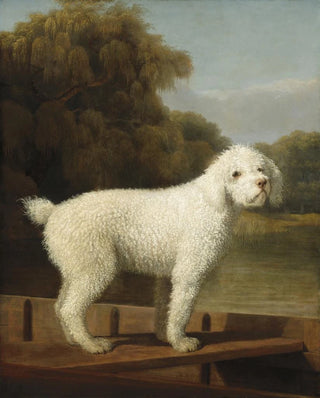White Poodle in a Pouch - George Stubbs


View from behind

Frame (optional)
Art print of a white poodle in a punt - George Stubbs – Captivating introduction
In the fascinating world of 18th-century British art, the work "White Poodle in a Punt" by George Stubbs stands out for its delicacy and boldness. This painting, which captures the very essence of a poodle peacefully floating on a pond, evokes a moment of serenity and natural beauty. Through this depiction, Stubbs invites the viewer to immerse themselves in a lively tableau where nature and the animal meet in perfect harmony. The piece does not merely portray a pet; it transcends this simple image to become a symbol of refinement and elegance, echoing a time when art and everyday life intertwined.
Style and uniqueness of the work
George Stubbs's style is often characterized by striking realism, and "White Poodle in a Punt" is no exception. The precision of details, from the silky coat of the poodle to the reflections on the water, demonstrates meticulous observation and impressive technical mastery. Stubbs succeeds in capturing the vitality and personality of the animal, while integrating the surrounding landscape into a balanced composition. The color palette, soft and luminous, creates a soothing atmosphere, while the posture of the poodle, both alert and relaxed, adds a dynamic dimension to the piece. This painting, with its apparent simplicity, reveals an emotional depth that invites contemplation.
The artist and his influence
George Stubbs, born in 1724, is often regarded as one of the greatest animal painters of his time. His passion for studying horses and domestic animals revolutionized how these subjects were depicted in art. Stubbs combined science and aesthetics, relying on detailed anatomical studies to bring his subjects to life with unmatched veracity. His influence extends far beyond his era, inspiring many contemporary and future artists to explore the relationship between humans and animals in their works. Through "White Poodle in a Punt," he demonstrates not only his talent but also his ability to capture the spirit of his time, thus marking a turning point in

Matte finish

View from behind

Frame (optional)
Art print of a white poodle in a punt - George Stubbs – Captivating introduction
In the fascinating world of 18th-century British art, the work "White Poodle in a Punt" by George Stubbs stands out for its delicacy and boldness. This painting, which captures the very essence of a poodle peacefully floating on a pond, evokes a moment of serenity and natural beauty. Through this depiction, Stubbs invites the viewer to immerse themselves in a lively tableau where nature and the animal meet in perfect harmony. The piece does not merely portray a pet; it transcends this simple image to become a symbol of refinement and elegance, echoing a time when art and everyday life intertwined.
Style and uniqueness of the work
George Stubbs's style is often characterized by striking realism, and "White Poodle in a Punt" is no exception. The precision of details, from the silky coat of the poodle to the reflections on the water, demonstrates meticulous observation and impressive technical mastery. Stubbs succeeds in capturing the vitality and personality of the animal, while integrating the surrounding landscape into a balanced composition. The color palette, soft and luminous, creates a soothing atmosphere, while the posture of the poodle, both alert and relaxed, adds a dynamic dimension to the piece. This painting, with its apparent simplicity, reveals an emotional depth that invites contemplation.
The artist and his influence
George Stubbs, born in 1724, is often regarded as one of the greatest animal painters of his time. His passion for studying horses and domestic animals revolutionized how these subjects were depicted in art. Stubbs combined science and aesthetics, relying on detailed anatomical studies to bring his subjects to life with unmatched veracity. His influence extends far beyond his era, inspiring many contemporary and future artists to explore the relationship between humans and animals in their works. Through "White Poodle in a Punt," he demonstrates not only his talent but also his ability to capture the spirit of his time, thus marking a turning point in






